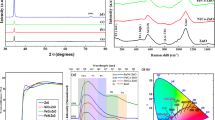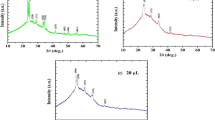Abstract
Zinc titanate (ZnTiO3) was grown on silicon and porous silicon. ZnTiO3 layers were prepared by sol-gel method. Porous silicon was fabricated by electrochemical etching of silicon in HF solution. The effect of substrate porosity on morphology, structure and otpical properties of ZnTiO3 nanostructures has been studied. Theses properties were investigated using XRD, Ultraviolet–Visible spectroscopy, and HRTEM. Some important parameters (absorption, reflectivity (R (%) and grain size) were studied. It was found that the Structural, morphology and optical properties of ZnTiO3 layers are dependent strongly on the type of substrates. The crystalline size decreased for ZnTiO3 layers deposited on PS substrate. The average grain size is about 80 nm for ZnTiO3 grown on porous silicon. The surface morphology of films was also found to be uniform and homogeneous. ZnTiO3-PS shows enhancing photon absorption compared to ZnTiO3-Si.
Similar content being viewed by others
Data Availability
Not applicable.
References
Fatima H, Azhar MR, Khiadani M, Zhong Y, Wang W, Su C, Shao Z (2022) Prussian blue-conjugated ZnO nanoparticles for near-infrared light-responsive photocatalysis. Materials Today Energy 23:100895. https://doi.org/10.1016/j.mtener.2021.100895
Özdemir AO, Caglar B, Çubuk O, Coldur F, Kuzucu M, Guner EK, Doğan B, Caglar S, Özdokur KV (2022) Facile synthesis of TiO2-coated cotton fabric and its versatile applications in photocatalysis, pH sensor and antibacterial activities. Mater Chem Phys 287:126342. https://doi.org/10.1016/j.matchemphys.2022.126342
Li Y, Min F, Wang R, Siwei W, Tan X (2022) Efficient removal TC by Zn@SnO2/PI via the synergy of adsorption and photocatalysis under visible light. Chem Eng J 444:136567. https://doi.org/10.1016/j.cej.2022.136567
Dhatarwal P, Sengwa RJ (2021) Poly(vinyl pyrrolidone) matrix and SiO2, Al2O3, SnO2, ZnO, and TiO2 nanofillers comprise biodegradable nanocomposites of controllable optical properties for optoelectronic application. Optik 241:167215. https://doi.org/10.1016/j.ijleo.2021.167215
Fan W, Qiao Q, Bahrami B, Chen K, Pathak R, Mabrouk S, Tong Y, Li X, Zhang T, Jian R (2018) Comparison of performance and optoelectronic processes in ZnO and TiO2 nanorod array-based hybrid solar cells. Appl Surf Sci 456:124. https://doi.org/10.1016/j.apsusc.2018.06.097
Senthilkumar P, Raja S, Ramesh Babu R, Vasuki G (2022) Enhanced electrical and optoelectronic properties of W doped SnO2 thin films. Opt Mater 126:112234. https://doi.org/10.1016/j.optmat.2022.112234
Bakour A, Saadoune A, Bouchama I, Dhiabi F, Boudour S, Saeed MA (2022) Effect and optimization of ZnO layer on the performance of GaInP/GaAs tandem solar cell. Micro Nanostructures 168:207294. https://doi.org/10.1016/j.micrna.2022.207294
Al-She'irey AY, Balouch A, Mawarnis ER, Roza L, Rahman MYA, Abdullah, Mahar AM (2022) Effect of ZnO seed layer annealing temperature on the growth of ZnO nanorods and its catalytic application. Opt Mater 131:112652. https://doi.org/10.1016/j.optmat.2022.112652
Lu T s, Lv J, Wang C (2022) Hydrogenation process enhances radiation-stability of ZnO, Ga2O3 and TiO2. J Alloys Compd 897:163135. https://doi.org/10.1016/j.jallcom.2021.163135
Enebe GC, Lukong VT, Mouchou RT, Ukoba KO, Jen T-C (2022) Optimizing nanostructured TiO2/Cu2O pn heterojunction solar cells using SCAPS for fourth industrial revolution. Mater Today: Proc 62:S145. https://doi.org/10.1016/j.matpr.2022.03.485
Tian X, Cui X, Lai T, Ren J, Yang Z, Xiao M, Wang B, Xiao X, Wang Y (2021) Gas sensors based on TiO2 nanostructured materials for the detection of hazardous gases: a review. Nano Mater Sci 3:390. https://doi.org/10.1016/j.nanoms.2021.05.011
Koley S (2021) Engineering Si doping in anatase and rutile TiO2 with oxygen vacancy for efficient optical application. Phys B Condens Matter 602:412502. https://doi.org/10.1016/j.physb.2020.412502
Kumar RR, Kumar KU, Haranath D (2022) Synthesis, characterization, and applications of ZnO–TiO2 nanocomposites. Nanoscale Compound Semiconductors and their Optoelectronics Applications Woodhead Publishing Series in Electronic and Optical Materials 271. https://doi.org/10.1016/B978-0-12-824062-5.00011-7
Jiang Q, Han Z, Qian Y, Yuan Y, Ren Y, Wang M, Cheng Z (2022) Enhanced visible-light photocatalytic performance of ZIF-8-derived ZnO/TiO2 nano-burst-tube by solvothermal system adjustment. J Water Process Eng 47:102768. https://doi.org/10.1016/j.jwpe.2022.102768
Thi TDN, Nguyen LH, Nguyen XH, Phung HV, Vinh THT, Van Viet P, Van Thai N, Le HN, Pham DT, Van HT, Thi LHT, Thi TDP, Le Minh T, Quang HHP, Hoang Phuong Nguyen V, Duc TT, Nguyen HM (2022) Enhanced heterogeneous photocatalytic perozone degradation of amoxicillin by ZnO modified TiO2 nanocomposites under visible light irradiation. Mater Sci Semicond Process 142:106456. https://doi.org/10.1016/j.mssp.2022.106456
Heng Z, Wan Y, Xia C (2022) Calcium stabilized La0.6Sr0.4Fe0.8Mn0.2O3-δ perovskite as ceramic fuel electrode for solid oxide cell. J Power Sources 537:231535. https://doi.org/10.1016/j.jpowsour.2022.231535
Flores-Lasluisa JX, Huerta F, Cazorla-Amorós D, Morallón E (2022) Transition metal oxides with perovskite and spinel structures for electrochemical energy production applications. Environ Res 214:113731. https://doi.org/10.1016/j.envres.2022.113731
Syue Y-K, Hsu K-C, Fang T-H, Lee C-I, Shih C-J (2022) Characteristics and gas sensor applications of ZnO-perovskite heterostructure. Ceram Int 48:12585. https://doi.org/10.1016/j.ceramint.2022.01.126
Ashiq MGB, Mahmood Q, Haq BU, Flemban TH, Kattan NA, Alshahrani T, Laref A (2022) The study of electronics, optoelectronics, thermoelectric, and mechanical properties of Zn/CdSnO3 perovskites. Mater Sci Semicond Process 137:106229. https://doi.org/10.1016/j.mssp.2021.106229
Feng C, Gao Q, Xiong G, Chen Y, Pan Y, Fei Z, Li Y, Yukun L, Liu C, Liu Y (2022) Defect engineering technique for the fabrication of LaCoO3 perovskite catalyst via urea treatment for total oxidation of propane. Appl Catal B Environ 304:121005. https://doi.org/10.1016/j.apcatb.2021.121005
Kavitha K, Sivakumar A (2022) Synthesis and characterisation of cerium doped bismuth titanate proficient UV shielding and NIR reflective reddish brown pigment by citrate auto combustion synthesis. Inorg Chem Commun 136:109162. https://doi.org/10.1016/j.inoche.2021.109162
Singh S, Perween S, Ranjan A (2021) Dramatic enhancement in adsorption of Congo red dye in polymer-nanoparticle composite of polyaniline-zinc titanate. J Environ Chem Eng 9:105149. https://doi.org/10.1016/j.jece.2021.105149
Hidehito O, Yo S, Tetsuo G (1976) Perovskite-type oxides as ethanol sensors. J Solid State Chem 17:299. https://doi.org/10.1016/0022-4596(76)90135-3
Tae KH, Sahn N, Dong BJ, Yoonho K (1999) Low-fired (Zn,Mg)TiO3 microwave dielectrics. J Am Ceram Soc 82:3476. https://doi.org/10.1111/j.1151-2916.1999.tb02268.x
Lv J, Tang M, Quan R, Chai Z (2019) Synthesis of solar heat reflective ZnTiO3 pigments with novel roof cooling effect. Ceram Int 45:15768. https://doi.org/10.1016/j.ceramint.2019.05.081
Tuna Ö, Simsek EB, Sarıoğlan A, Çetin YD (2020) Multifunctional and highly active zinc titanate incorporated with copper for adsorptive hot syngas desulfurization and photocatalytic dye degradation. J Taiwan Inst Chem Eng 112:388. https://doi.org/10.1016/j.jtice.2020.04.008
Bartram S, Slepetys RA (1961) Compound formation and crystal structure in the system ZnO-TiO2. J Am Ceram Soc 44:493. https://doi.org/10.1111/J.1151-2916.1961.TB13712.X
Yamaguchi O, Morimi M, Kawabata H, Shimizu K (1987) Formation and transformation of ZnTiO3. J Am Ceram Soc 70:97. https://doi.org/10.1111/j.1151-2916.1987.tb05011.x
Chang Y-S, Chang Y-H, Chen I-G, Chen G-J, Chai Y-L (2002) Synthesis and characterization of zinc titanate nano-crystal powders by sol–gel technique. J Cryst Growth 243:319. https://doi.org/10.1016/S0022-0248(02)01490-2
Chai Y-L, Chang Y-S, Chen G-J, Hsiao Y-J (2008) The effects of heat-treatment on the structure evolution and crystallinity of ZnTiO3 nano-crystals prepared by Pechini process. Mater Res Bull 43:1066. https://doi.org/10.1016/j.materresbull.2007.06.002
Wang C-L, Chu H-L, Ko H-H, His C-S, Li W-L, Hwang W-S, Chang K-M, Wang M-C (2015) Phase formation mechanism of the zinc titanate precursor powders prepared at various pH using a hydrothermal process. Ceram Int 41:2028. https://doi.org/10.1016/j.ceramint.2014.09.131
Shyh-Chi W, Jeng Y-R, Yau W-H, Kuan-Te W, Tsai C-H, Chou C-P (2012) Nanoindentation response of zinc titanate thin films deposited by co-sputtering process. Appl Surf Sci 258:6730. https://doi.org/10.1016/j.apsusc.2012.02.076
Gonzales LL, da Silva Hartwig M, Fassbender RU, Moreira EC, Pereira MB, Jardim PLG, Raubach CW, Moreira ML, Cava SS (2021) Properties of zinc titanates synthesized by microwave assisted hydrothermal method. Heliyon 7:e06521. https://doi.org/10.1016/j.heliyon.2021.e06521
Liu X (2012) Molten salt synthesis of ZnTiO3 powders with around 100 nm grain size crystalline morphology. Mater Lett 80:69. https://doi.org/10.1016/j.matlet.2012.04.048
Phani AR, Passacantando M, Santucci S (2007) Synthesis of nanocrystalline ZnTiO3 perovskite thin films by sol–gel process assisted by microwave irradiation. J Phys Chem Solids 68:317. https://doi.org/10.1016/j.jpcs.2006.09.010
Morsi RMM, Margha FH, Hamzawy EMA (2019) Preparation and electrical characterization of Zn-Titanate / borosilicate glass composites. Silicon 11:1845. https://doi.org/10.1007/s12633-018-0003-1
Habibi MH, Mikhak M (2012) Titania/zinc oxide nanocomposite coatings on glass or quartz substrate for photocatalytic degradation of direct blue 71. Appl Surf Sci 258:6745. https://doi.org/10.1016/j.apsusc.2012.03.042
Jain PK, Salim M, Kaur D (2016) Effect of phase transformation on optical and dielectric properties of pulsed laser deposited ZnTiO3 thin films. Superlattice Microst 92:308. https://doi.org/10.1016/j.spmi.2016.02.018
Khudiar SS, Mutlak FA-H, Nayef UM (2021) Synthesis of ZnO nanostructures by hydrothermal method deposited on porous silicon for photo-conversion application. Optik 247:167903. https://doi.org/10.1016/j.ijleo.2021.167903
Rahmani N, Dariani RS (2016) Effect of porous silicon buffer under different porosities on lateral overgrowth of TiO2 nanorods on silicon substrate. J Alloys Compd 681:421. https://doi.org/10.1016/j.jallcom.2016.04.234
Rahmani N, Dariani RS, Rajabi M (2016) A proposed mechanism for investigating the effect of porous silicon buffer layer on TiO2 nanorods growth. Appl Surf Sci 366:359. https://doi.org/10.1016/j.apsusc.2016.01.075
Dutta DP, Singh A, Tyagi AK (2014) Ag doped and Ag dispersed nano ZnTiO3: improved photocatalytic organic pollutant degradation under solar irradiation and antibacterial activity. J Environ Chem Eng 2:2177. https://doi.org/10.1016/j.jece.2014.09.015
Raveendra RS, Prashanth PA, Hari Krishna R, Bhagya NP, Sathyanarayani S, Nagabhushana BM (2017) Carbothermal synthesis and photoluminescence characteristics of pure Undoped ZnTiO3 nanocrystals. J Adv Phys Sci 2:1. https://doi.org/10.1016/j.jece.2014.09.015
Abdulgafour HI, Yam FK, Hassan Z, AL-Heuseen K, Jawad MJ (2011) ZnO nanocoral reef grown on porous silicon substrates without catalyst. J Alloys Compd 509:5627. https://doi.org/10.1016/j.jallcom.2011.02.100
Habibi MH, Mikhak M (2011) Synthesis of Nanocrystalline zinc Titanate Ecandrewsite by sol-gel: optimization of heat treatment condition for red shift sensitization. Curr Nanosci 7:603. https://doi.org/10.2174/157341311796196754
Habibi MH, Mikhak M, Zendehdel M, Habibi M (2012) Influence of nanostructured zinc titanate, zinc oxide or titanium dioxide thin film coated on fluorine doped tin oxide as working electrodes for dye-sensitized solar cell. Int J Electrochem Sci 76787. Web of Science Id WOS:000307980800017
Acknowledgements
The authors would like to acknowledge financial support from the Research and Technology Centre of Energy (CRTEn).
Funding
This complete work has been fnancial supported by Research and Technology Centre of Energy (CRTEn).
Author information
Authors and Affiliations
Contributions
Marouan khalifa and Khadija hammedi wrote the main manuscript. Hatem Ezzaouia and Chaker Bouzidi prepared figures. All authors reviewed the manuscript.
Corresponding author
Ethics declarations
Ethics Approval
Not applicable.
Consent to Participate
Not applicable.
Consent for Publication
The Author hereby consents to the publication of the work in the “Silicon” journal.
Competing Interests
The author declares that there is no confict of interest in the printing of this manuscript.
Additional information
Publisher’s Note
Springer Nature remains neutral with regard to jurisdictional claims in published maps and institutional affiliations.
Rights and permissions
Springer Nature or its licensor (e.g. a society or other partner) holds exclusive rights to this article under a publishing agreement with the author(s) or other rightsholder(s); author self-archiving of the accepted manuscript version of this article is solely governed by the terms of such publishing agreement and applicable law.
About this article
Cite this article
Khalifa, M., Khadija, H., Bouzidi, C. et al. Morphological, Optical, and Crystalline Analysis of ZnTiO3 Nanostructures Deposited on Porous Silicon Substrate. Silicon 15, 2745–2752 (2023). https://doi.org/10.1007/s12633-022-02219-z
Received:
Accepted:
Published:
Issue Date:
DOI: https://doi.org/10.1007/s12633-022-02219-z




